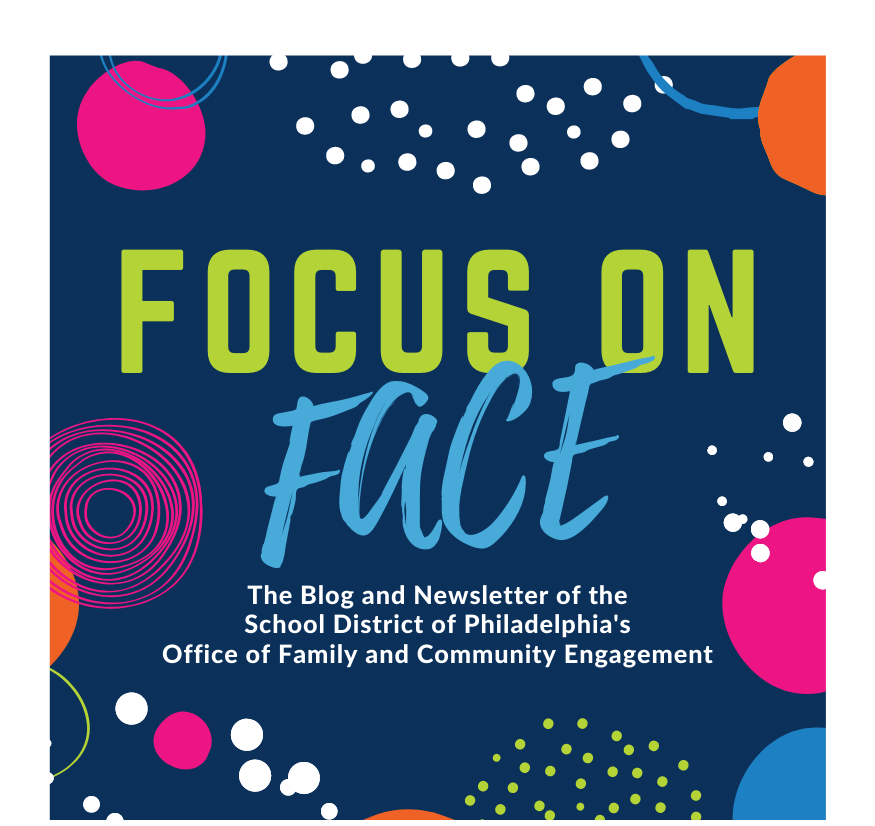
SAC Members and Guests.
“We own our actions. We put forth our best effort. We care for all.”
These three simple statements encompass the mission and values of Overbrook Educational Center (OEC). Located on the corner of Lansdowne and 68th Street in West Philadelphia, Overbrook Educational Center enrolls 277 students in grades K-8. OEC also includes the largest number of blind and visually impaired students of all schools in the District.
The school has made a huge effort to expand supports for these students. This year, it has added a life skills class, a Spanish class, and a community service program to ensure that the school’s entire student body is given the opportunities they deserve.
During OEC’s most recent SAC meeting, it was clear that the principal, staff, and families wanted to achieve many goals in order to improve the overall climate of the school as well as give students more support. Some of these goals include: an improved attendance rate, increased family engagement, fundraisers, and breaking ground on a school playground.
I had only visited Overbrook Educational Center once before to meet with one of my fellow AmeriCorps VISTA member who is serving as a Community Partnerships Coordinator at the school. I was eager pay her another visit because I heard that her school’s SAC was doing great things despite still being in the beginning phases.
I arrived about 15 minutes before the SAC meeting was supposed to begin. A woman at the front desk greeted me and told me that they were waiting for a meeting in the conference room to come to end, so they’d likely be starting late. She turned out to be the SAC facilitator and was quite welcoming.
 The SAC meeting started about 15 minutes late but everyone hit the ground running. We were all seated facing each other at a large round table, which was meant to welcome open conversation among all participants. The SAC meeting was led by the VISTA and the Principal assisted her.
The SAC meeting started about 15 minutes late but everyone hit the ground running. We were all seated facing each other at a large round table, which was meant to welcome open conversation among all participants. The SAC meeting was led by the VISTA and the Principal assisted her.
Families and students participated in a Family Literacy Night.
First, she provided a rundown of school events and gave an update about how they went. OEC recently hosted a Math Night and a Literacy Night, which were both well-attended and successful events. SAC members were asked to give feedback about the events if they had any.
After being asked, people were willing to open up about the one concern many of them had—it was difficult to plan events that catered to a K-8 crowd. Literacy Night seemed more geared towards younger students, while Math Night seemed more geared towards older students.
Almost instantly, the problem was solved. For future events, they would try to include a suggested grade range so families and students can decide whether or not the event would be helpful for them. The staff was so open to feedback and the concern that many people had was quickly resolved.
The next update was about how the school was combatting attendance problems. Everyone in the room listened intently as Sophia, the VISTA, explained that she along with the Principal and some other staff members had been making home visits to students who have frequent attendance problems. Last year, when the principal and staff made home visits, absences did decrease slightly, so they decided to follow the same game plan this year.
Sophia and the Principal disclosed that the home visits revealed a lot about different circumstances that affected their student body’s attendance. They planned to make follow-up calls and home visits later on. Families, community members, and staff reacted positively to how the school was handling attendance issues—it said a lot about how close and tight-knit the school is with its students and their families.
The next large issue to tackle was family engagement. The principal sought suggestions from people in the room for events that OEC could host that would promote family engagement. Using Math Night, Literacy Night, and an upcoming Movie Night hosted by the HSA as starting points, everyone began brainstorming suggestions.
 Game Night emerged as a popular event that most agreed would be fun for everybody. “People are going to make a priority for what they want to make priority,” one family member pointed out, breaking the flurry of ideas circling the table.
Game Night emerged as a popular event that most agreed would be fun for everybody. “People are going to make a priority for what they want to make priority,” one family member pointed out, breaking the flurry of ideas circling the table.
Families have fun learning with their students during a Family Math Night.
Suddenly, the discussion shifted to ways that the school can get families and students in the door to attend whatever events they decided on. Most agreed that promoting explicit benefits and offering food would be sure to draw a crowd at first and then hopefully families would have so much fun at the first few events that they would be eager to attend later ones. People are still going to make priority for the things they decide are important, but members of OEC’s SAC hoped that they’d be able to plan such amazing events that their school’s families would be happy to prioritize.
“You guys come to everything,” the Principal said to the SAC’s family representatives. “What would you like to see more of?” An interesting shift in the discussion occurred once she posed this question. There was a slight hesitation—the school’s most involved family members were being asked to put themselves first and divulge which events they enjoyed most in the past and what they would like to see more of. A population accustomed to planning with others in mind were thrust into a limelight that was meant solely for them. Game night! Karaoke! More Math and Literacy Nights! International Day! Suggestions came nonstop.
It seemed like the SAC members really enjoyed interactive events, especially ones that interconnected with an educational aspect, whether it be math or exposure to different cultures from around the world. Principal Foote welcomed every suggestion without restriction. She acknowledged everyone’s ideas and made sure that the group considered each one. Principal Foote even asked those who were hesitant to contribute and share any ideas they may have.
She was especially cognizant about including the few members from multilingual families and the sole male family member in attendance at the SAC meeting. It was refreshing to see the school staff, family members, and community members work together so seamlessly.
A point of contention rose when the topic of fundraisers came up. Someone made a suggestion that the school should charge admission to some of the family engagement events so that the event could raise funds as well as promote family engagement.
There was strong opposition to this from a couple of family members, who firmly believed that fundraisers and family engagement events should be kept separate. Charging admission would drastically curb accessibility to family engagement events. Larger families may be unable to pay for admission for every member of the family; some parents may decide to just drop students off at the event, which would go against the whole purpose of having a family engagement event.
The SAC also discussed how on the other hand, some events may be incredibly popular—too popular for school staff and volunteers to handle—so charging admission to these events may help make them more manageable.
The debate went on, but it never turned ugly. There was respectful disagreement but no hostility. Finally, Sophia mitigated the squabble by sharing an idea about a large fundraiser she envisioned: an evening gala, with all the bells and whistles, that would feature student performance.
At the end of the meeting, every single person in the room had at least one ‘action item,’ so that every

Families have fun learning with their students during a Family Math Night.
SAC member could be involved and the SAC could move forward with whatever it planned to accomplish in the coming months.Not everything goes perfectly during a SAC meeting. Not everyone agrees with everything said or suggested. And that’s okay. SAC meetings are meant to hash out details, address concerns regarding the goals the SAC hopes to achieve, and are an outlet for school staff, family members, and community members to work together to make their school a better place for everyone.
Overbrook Educational Center’s SAC meeting flowed well even when there were disagreements. Everyone was encouraged to contribute; the environment was welcoming and warm. Family members, community members, the principal, and school staff on the SAC are as close knit as a family, which seems to be the reason the SAC is so successful in accomplishing many of its goals. The SAC works cohesively towards objectives that everyone identifies together. When everyone is on the same page and there’s openness and transparency, any SAC can prosper the way OEC’s SAC has.

